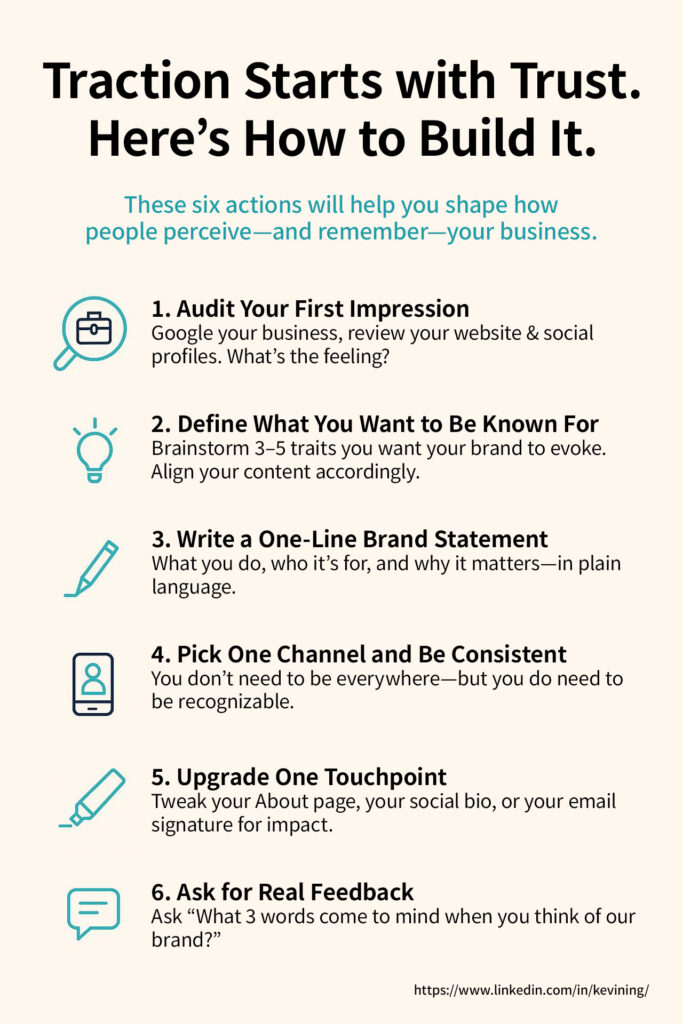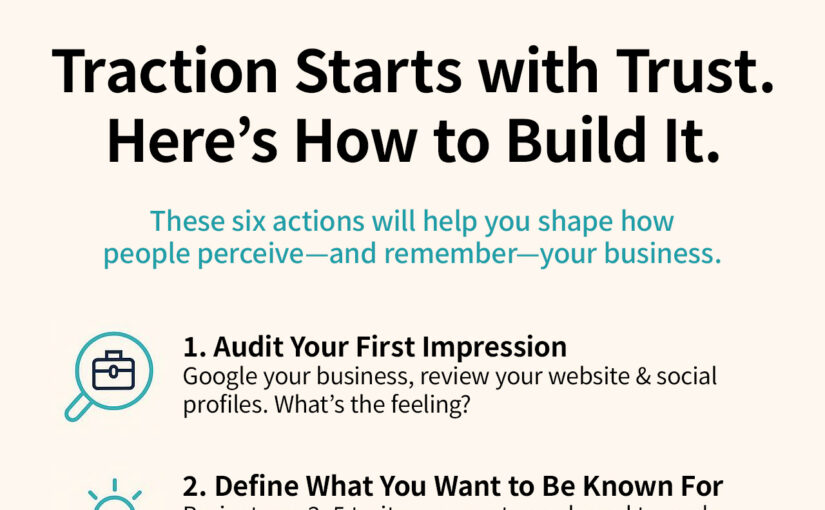If you’ve ever struggled to explain what your business is all about—or wondered why your amazing work isn’t translating into more leads or referrals—this post is for you.
You don’t need a viral campaign. You don’t need a polished logo or a trendy color palette.
But you do need a brand—and probably not the kind you’re thinking of.
This post isn’t for marketing professionals or corporate comms teams.
It’s for small business owners, startup founders, consultants, and anyone building a reputation without the support of a full marketing department.
Because even if you don’t think you have a “brand,” the truth is—you already do.
The only question is whether you’re shaping it intentionally… or leaving it to chance.
In this post, we’ll bust a few myths, clarify the difference between branding, marketing, and PR—and share practical steps you can take (with your team) to start building a brand that resonates.
👇 Want to skip ahead?
Download the 1-page PDF summary of the 6 action items here
Common Misconceptions About Branding
Most people outside of the marketing world think of a brand as something visual—your logo, your colors, your business card design.
And while those are all important tools, they’re not your brand.
Here are some of the most common myths I hear:
“Your brand is your logo.”
→ Your logo is a symbol of your brand—not the brand itself.
“Branding is only for big companies.”
→ If you’re doing business, people are forming impressions of you. That is your brand.
“Marketing drives sales. Branding is optional.”
→ Branding builds familiarity and trust, which make your marketing work better.
“Our brand is what we say it is.”
→ Not quite. Your brand lives in the minds of others—it’s the sum of how people experience you.
“It’s all in the style guide.”
→ A consistent visual identity helps, but branding goes far beyond what fonts you use.
Key takeaway: Your brand is not what you say—it’s the impression you leave behind.
So What Is a Brand, Then?
At its core, a brand is an emotional response.
It’s what someone thinks, feels, and says about your business when you’re not there with them.
Or as Jeff Bezos famously put it:
“Your brand is what people say about you when you’re not in the room.”
It’s their gut reaction to your name, your website, your tone, your work, and their last experience with you.
It’s not a thing you own.
It’s something you shape—through consistency, credibility, and experience.
You don’t build a brand overnight. You build it moment by moment, through every customer interaction, every touchpoint, every follow-up message. And the stronger the feeling, the more likely someone is to remember you—and refer you.
Marketing vs. PR vs. Branding: What’s the Difference?
Understanding how these terms relate to each other helps clarify what a brand actually is:
| Discipline | Core Role | Influences Brand? |
| Marketing | What you say about yourself to drive action | ✅ Yes |
| Public Relations | What others say about you publicly | ✅ Yes |
| Branding | What people feel about you | It’s the outcome of both—and more |
Here’s one way to frame it:
- Marketing is what you say.
- PR is what others say about you.
- Your brand is what people feel—whether or not you’re in the room.
That feeling is shaped by every interaction with your business:
- Your website and messaging
- Your tone in emails
- Your pricing and onboarding
- Your response time
- Your packaging or proposals
- Your social posts and even your silence
It’s holistic. Branding isn’t just a campaign or a style—it’s the total experience.
Your Brand Is a Feeling—Not a File
A great brand feels:
- Clear
- Familiar
- Trustworthy
- Professional
- Aligned with the customer’s values or needs
Think of the brands that stand out to you:
Apple. Nike. Disney. Red Bull. Patagonia. You can picture them instantly—and likely feel something when you do. Those feelings weren’t created by accident.
Now, you don’t need global reach to create a memorable brand.
But even as a one-person business or small team, you can shape how people experience you.
And when that experience is aligned, consistent, and authentic—that’s when the brand starts to work for you.

Getting Started: Simple First Steps to Build Your Brand
You don’t need a full rebrand or an expensive agency to start shaping your brand. If you’re a startup founder, small business owner, or part of a lean team—you can make meaningful progress with a few sticky notes, some open time, and a shared doc.
In fact, many of these can be tackled as a collaborative workshop with your co-founders or key team members. You’ll get aligned, generate useful insights, and walk away with clarity on how you want to show up in the world.
Here are six easy ways to begin:
1. Audit your first impression.
Pull up your website, social media profiles, and search results. Do they reflect the tone, personality, and values you want to communicate?
💡 Workshop tip: Have each person review the brand’s online presence and write down the first 3 adjectives that come to mind—then compare.
2. Define what you want to be known for.
What kind of emotional response do you want your brand to evoke?
As a group, brainstorm a few qualities you want people to associate with your business (e.g. expert, approachable, bold, premium, caring).
Then ask: Does our current brand reflect these ideas—visually, verbally, and behaviorally?
3. Write a one-line brand statement.
This isn’t a mission statement. It’s just a clear, conversational sentence that explains:
- What you do
- Who it’s for
- Why it matters
Example: “We help small businesses grow their audience through strategic, low-cost content marketing.”
💡 Workshop tip: Have each person write their version individually, then compare and refine together.
4. Pick one channel and commit to consistency.
You don’t need to be everywhere. But you do need to be recognizable wherever you show up.
Pick one priority channel (website, Instagram, LinkedIn, etc.) and align your tone, voice, and visuals.
Ask: If a customer found us here for the first time, would they understand what we’re about?
5. Upgrade one touchpoint.
Choose one thing your clients, customers, or audience sees—and make it better:
- Rewrite your About page to reflect your voice and values
- Clean up your social media bio
- Replace a stock image with a real team photo
- Create a simple welcome video (yes, with a good mic!)
This isn’t about perfection—it’s about progress.
6. Ask for real feedback.
Reach out to 3–5 customers, collaborators, or friendly clients and ask:
“When you think of our brand, what 3 words come to mind?”
Then compare it to what you want your brand to represent.
Gaps are your starting points.
👇 Want to keep this handy?
Download the free PDF version of the 6 brand-building actions poster here
(No email signup required)
Final Thought: What Feeling Are You Leaving Behind?
At the end of the day, your brand isn’t a logo or a tagline.
It’s the feeling people are left with after they interact with your business.
And when that feeling is clear, credible, and consistent, your brand becomes more than an identity—it becomes a magnet for trust, engagement, and growth.

